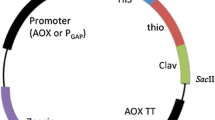Abstract
Cystatin 11 (CST11) belongs to the cystatin type 2 family of cysteine protease inhibitors and exhibits antimicrobial activity in vitro. In this study, we describe the expression and purification of recombinant porcine CST11 in the Pichia pastoris system. We then assess its antimicrobial activity against Escherichia coli, Staphylococcus aureus, Staphylococcus epidermidis, and Bacillus subtilis by liquid growth inhibition assay. Kinetic studies indicate that the recombinant porcine CST11 has high potency against E. coli and S. aureus. Scanning electronic microscope analysis showed that CST11 might be targeting the bacterial membrane and, thus, could potentially be developed as a therapeutic agent for inhibiting microbe infection without the risk of antibiotic resistance.





Similar content being viewed by others
References
Li, Y., Xiang, Q., Zhang, Q., Huang, Y., & Su, Z. (2012). Overview on the recent study of antimicrobial peptides: origins, functions, relative mechanisms and application. Peptides, 37(2), 207–215. doi:10.1016/j.peptides.2012.07.001.
Ma, D. M., Bai, J. J., Jian, Q., Lao, H. H., Ye, X., & Luo, J. R. (2003). Expression of Chinese sturgeon cystatin in yeast Pichia pastoris and its proteinase inhibitory activity analysis. Sheng wu gong cheng xue bao = Chinese Journal of Biotechnology, 19(5), 598–602.
Magister, S., & Kos, J. (2013). Cystatins in immune system. Journal of Cancer, 4(1), 45–56. doi:10.7150/jca.5044.
Keppler, D. (2006). Towards novel anti-cancer strategies based on cystatin function. Cancer Letters, 235(2), 159–176. doi:10.1016/j.canlet.2005.04.001.
Li, Y., Putnam-Lawson, C. A., Knapp-Hoch, H., Friel, P. J., Mitchell, D., Hively, R., & Griswold, M. D. (2005). Immunolocalization and regulation of cystatin 12 in mouse testis and epididymis. Biology of Reproduction, 73(5), 872–880. doi:10.1095/biolreprod.105.040238.
Hamil, K. G., Liu, Q., Sivashanmugam, P., Yenugu, S., Soundararajan, R., Grossman, G., Richardson, R. T., Zhang, Y. L., O’Rand, M. G., Petrusz, P., French, F. S., & Hall, S. H. (2002). Cystatin 11: a new member of the cystatin type 2 family. Endocrinology, 143(7), 2787–2796.
Wang, L., Yuan, Q., Chen, S., Cai, H., Lu, M., Liu, Y., & Xu, C. (2012). Antimicrobial activity and molecular mechanism of the CRES protein. PLoS ONE, 7(11), e48368. doi:10.1371/journal.pone.0048368.
Sreekrishna, K. (1993). Strategies for optimizing protein expression and secretion in the methylotrophic yeast Pichia pastoris. in Industrial Microorganism: Basic and Applied Molecular Genetics (Baltz, R. H., Hegeman, G. D., Skatrud, P. L., eds.), American Society of Microbiology, Washington, DC, pp. 119–126.
Peraino, J., Zhang, H., Hermanrud, C. E., Li, G., Sachs, D. H., Huang, C. A., & Wang, Z. (2012). Expression and purification of soluble porcine CTLA-4 in yeast Pichia pastoris. Protein Expression and Purification, 82(2), 270–278. doi:10.1016/j.pep.2012.01.012.
Yan, J. X., Wang, K. R., Chen, R., Song, J. J., Zhang, B. Z., Dang, W., Zhang, W., & Wang, R. (2012). Membrane active antitumor activity of NK-18, a mammalian NK-lysin-derived cationic antimicrobial peptide. Biochimie, 94(1), 184–191. doi:10.1016/j.biochi.2011.10.005.
Peng, H., Yang, M., Huang, W. S., Ding, J., Qu, H. D., Cai, J. J., Zhang, N., & Wang, K. J. (2010). Soluble expression and purification of a crab antimicrobial peptide scygonadin in different expression plasmids and analysis of its antimicrobial activity. Protein Expression and Purification, 70(1), 109–115. doi:10.1016/j.pep.2009.09.008.
Qu, H., Chen, B., Peng, H., & Wang, K. (2013). Molecular cloning, recombinant expression, and antimicrobial activity of EC-hepcidin3, a new four-cysteine hepcidin isoform from Epinephelus coioides. Bioscience, Biotechnology, and Biochemistry, 77(1), 103–110.
Seo, M. D., Won, H. S., Kim, J. H., Mishig-Ochir, T., & Lee, B. J. (2012). Antimicrobial peptides for therapeutic applications: a review. Molecules, 17(10), 12276–12286. doi:10.3390/molecules171012276.
Acknowledgments
This research was sponsored by the Key Scientific and Technological Project of Shanxi Province (Grant No. 20100312016). These experiments comply with the current laws of China.
Conflict of Interest
The authors have no conflict of interest to report.
Author information
Authors and Affiliations
Corresponding author
Rights and permissions
About this article
Cite this article
Fan, K., Jiang, J., Wang, Z. et al. Expression and Purification of Soluble Porcine Cystatin 11 in Pichia pastoris . Appl Biochem Biotechnol 174, 1959–1968 (2014). https://doi.org/10.1007/s12010-014-1148-z
Received:
Accepted:
Published:
Issue Date:
DOI: https://doi.org/10.1007/s12010-014-1148-z




